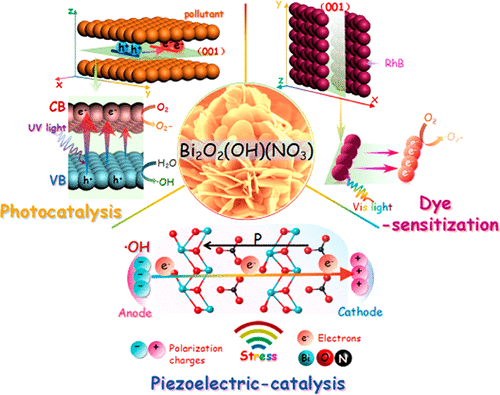当前位置:
X-MOL 学术
›
ACS Sustain. Chem. Eng.
›
论文详情
Our official English website, www.x-mol.net, welcomes your feedback! (Note: you will need to create a separate account there.)
Multifunctional Bi2O2(OH)(NO3) Nanosheets with {001} Active Exposing Facets: Efficient Photocatalysis, Dye-Sensitization, and Piezoelectric-Catalysis
ACS Sustainable Chemistry & Engineering ( IF 8.4 ) Pub Date : 2018-01-16 00:00:00 , DOI: 10.1021/acssuschemeng.7b03223 Lin Hao 1 , Hongwei Huang 1 , Yuxi Guo 1 , Yihe Zhang 1
ACS Sustainable Chemistry & Engineering ( IF 8.4 ) Pub Date : 2018-01-16 00:00:00 , DOI: 10.1021/acssuschemeng.7b03223 Lin Hao 1 , Hongwei Huang 1 , Yuxi Guo 1 , Yihe Zhang 1
Affiliation

|
Exploration for multiresponsive catalytic materials and synthesis of highly active exposing crystal facets are challenging subjects for catalysis research. In this work, well-defined Bi2O2(OH)(NO3) nanosheets (BON-S) with a dominantly exposed {001} active facet were synthesized by a sodium-dodecyl-benzenesulfonate-assisted (SDBS-assisted) soft-chemical route. BON-S presents far superior photocatalytic activity compared to bulk materials as well as a universal performance for degradation of contaminants and antibiotics under UV light. The profoundly enhanced photocatalytic activity basically stems from the largely shortened diffusion pathway of photogenerated electrons (e–) and holes (h+), favoring their migration from bulk to the surface of the catalyst under the internal electric field between [Bi2O2(OH)]+ and NO3– layers along the [001] direction. The photocatalytic active species production rates of BON-S are determined to be 3.14 μmol L–1 min–1 for superoxide radicals (•O2–) and 0.03 μmol L–1 min–1 for hydroxyl radicals (•OH). BON-S also shows an enhanced visible-light-responsive dye-sensitization degradation activity with Rhodamine B (RhB) as a sensitized medium to provide photoinduced e–. Moreover, for the first time we unearth that Bi2O2(OH)(NO3) demonstrates an ultrasonic-assisted piezoelectric-catalytic performance for decomposition of methyl orange, bisphenol A, and tetracycline hydrochloride, and •OH dominates the piezoelectric-catalytic process with an evolution rate of 7.13 μmol L–1 h–1, which far exceeds the photocatalytically induced one. This study may cast new inspiration on developing a new microstructure-design strategy for high photocatalytic/dye-sensitization performance, and furnishes a novel piezoelectric-catalytic material for environmental applications.
中文翻译:

具有{001}主动曝光面的多功能Bi 2 O 2(OH)(NO 3)纳米片:有效的光催化,染料敏化和压电催化
多反应催化材料的探索和高活性暴露晶面的合成是催化研究的挑战性课题。在这项工作中,由十二烷基苯磺酸钠辅助(SDBS辅助)的软质合成了具有显着暴露的{001}活性面的轮廓分明的Bi 2 O 2(OH)(NO 3)纳米片(BON-S)。 -化学路线。与块状材料相比,BON-S具有优异的光催化活性,并具有在紫外线下降解污染物和抗生素的通用性能。的深刻增强光催化活性基本上从光生电子(e的很大程度上缩短扩散路径茎-和空穴(h)+),有利于之间的内部电场的作用下从大容量到催化剂表面的迁移[毕2 ö 2(OH)] +和NO 3 -沿着[001]方向的层。BON-S的光催化活性物种的生产速率被确定为3.14微摩尔大号-1分钟-1为超氧自由基(• ö 2 - )和0.03微摩尔大号-1分钟-1羟基自由基(• OH)。BON-S还显示出增强的可见光响应性染料敏化降解活性,若丹明B(RhB)作为敏化介质提供光诱导的e –。此外,我们首次发现Bi 2 O 2(OH)(NO 3)表现出超声波辅助的压电催化性能,用于分解甲基橙,双酚A和四环素盐酸盐,而• OH在压电催化中占主导地位这一过程的演化速率为7.13μmolL –1 h –1,远远超过了光催化诱导的速率。这项研究可能会为开发一种新的高光催化/染料敏化性能的微结构设计策略提供新的灵感,并为环境应用提供一种新型的压电催化材料。
更新日期:2018-01-16
中文翻译:

具有{001}主动曝光面的多功能Bi 2 O 2(OH)(NO 3)纳米片:有效的光催化,染料敏化和压电催化
多反应催化材料的探索和高活性暴露晶面的合成是催化研究的挑战性课题。在这项工作中,由十二烷基苯磺酸钠辅助(SDBS辅助)的软质合成了具有显着暴露的{001}活性面的轮廓分明的Bi 2 O 2(OH)(NO 3)纳米片(BON-S)。 -化学路线。与块状材料相比,BON-S具有优异的光催化活性,并具有在紫外线下降解污染物和抗生素的通用性能。的深刻增强光催化活性基本上从光生电子(e的很大程度上缩短扩散路径茎-和空穴(h)+),有利于之间的内部电场的作用下从大容量到催化剂表面的迁移[毕2 ö 2(OH)] +和NO 3 -沿着[001]方向的层。BON-S的光催化活性物种的生产速率被确定为3.14微摩尔大号-1分钟-1为超氧自由基(• ö 2 - )和0.03微摩尔大号-1分钟-1羟基自由基(• OH)。BON-S还显示出增强的可见光响应性染料敏化降解活性,若丹明B(RhB)作为敏化介质提供光诱导的e –。此外,我们首次发现Bi 2 O 2(OH)(NO 3)表现出超声波辅助的压电催化性能,用于分解甲基橙,双酚A和四环素盐酸盐,而• OH在压电催化中占主导地位这一过程的演化速率为7.13μmolL –1 h –1,远远超过了光催化诱导的速率。这项研究可能会为开发一种新的高光催化/染料敏化性能的微结构设计策略提供新的灵感,并为环境应用提供一种新型的压电催化材料。



























 京公网安备 11010802027423号
京公网安备 11010802027423号